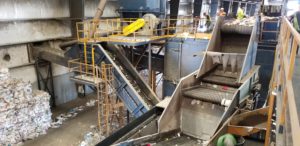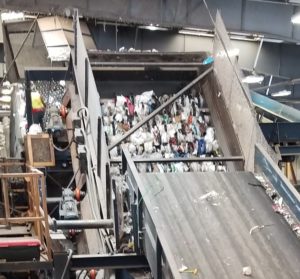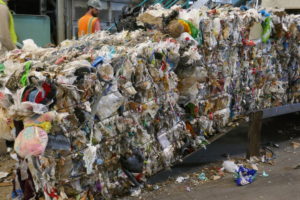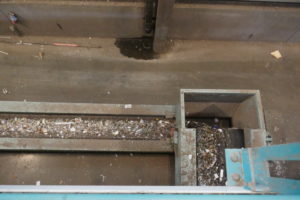Beyond the Blue Bin
How Single Stream Recycling Works (and When it Doesn't)
By Kaiba White
Recycling is often considered the gateway to environmentalism. It’s relatively simple – just put that bottle in the blue bin instead of the trash can. But, while recycling is something everyone can and should do, it’s actually a bit more complicated once you get beyond the blue bin.
Single stream recycling has the benefit of making recycling easy for the consumer, but it adds considerable complexity in processing. All of the different materials that we throw together in the blue bins at home, at work, at the park or anywhere else must be separated to enable them to actually be recycled (remade into new products).
My colleague, Stephanie Thomas, and I recently toured three different materials recovery facilities (MRFs) in Texas. The two I visited – Balcones Resources in Austin and Texas Disposal Systems in Creedmoor (just south of Austin) – both process material from Austin’s residential single stream recycling program, as well as commercial haulers. Texas Disposal Systems also processes material from San Antonio’s single stream recycling service. Stephanie visited the new FCC Environmental Services facility in Houston, which sorts material for the City of Houston, among others.
Sophisticated Machinery, Paired with the Human Touch

At FCC Environmental Services, the sorting process is fully mechanized. At Balcones Resources and Texas Disposal Systems, state of the art technology, as well as quick-moving human hands are sorting out our mess. The machinery is optimized for sorting containers, paper and cardboard. Other items also get recycled, but rely mostly on manual sorting. The human element is critical.
Texas Disposal Systems put a notable focus on manual sorting, with more workers positioned at various points along the line and the line appeared to be moving slower. This seemed to result in more complete removal of contaminants (many plastic bags) and less inadvertent removal of recyclable material.
The Contamination Problem

Waste is moved from a pile to a conveyor belt, where workers move quickly to try to pull out the most problematic contamination. Contaminants generally do one of two things – clog up the equipment (causing downtime) or ruin material that would otherwise be recyclable. In both cases, contamination is driving up costs at a time when the recycling industry is struggling. Those struggles are also related to contamination. China has instituted a Green Fence policy that bars imports of many materials because too much contaminated recycling material was ending up as waste there. Material from residential customers is generally more contaminated than material from commercial customers.
Worst Contaminants that Clog Up Equipment
- Plastic bags – the #1 offender
- Hoses
Worst Contaminants for Ruining Recyclable Material
- Diapers
- Food and liquid
- Plastic bags (they can pass through the system with the paper)
Most Horrible Contaminants
- Hazardous waste, such as batteries (poses a danger to workers and groundwater contamination when disposed of improperly)
- Dead animals (both sad and gross)

Contamination rates can vary considerably from place to place. Balcones Resources and Texas Disposal Systems average about 15% “residuals” (material that goes to the landfill). FCC Environmental Services in Houston averages 37%. Texas Disposal Systems has identified diapers as a key problem contaminant in the material coming from San Antonio. That’s why San Antonio now levies fines on customers who put diapers in their blue bins. FCC Environmental Services mentioned that they find dead animals in with recycling fairly often.
Some of the contamination (diapers, dead animals, food) are clearly not recyclable. Perhaps the only remedy is fines. Other contamination is what some call “aspirational recycling” or “wishcycling.” Hoses and plastic bags could be in this category. People think they might be recyclable, or should be recyclable, so they throw them in the blue bin. Education may be useful in reducing aspirational recycling.
The Takeaway: People using recycling bins as trash cans and engaging in aspirational recycling drives up costs and can result in less material actually being recycled. Cities and haulers need to get serious about education and also about enforcement of what is allowed in the blue bin.
What Happens with the Small Stuff?
One of the earliest steps in the process is to sort out the paper and cardboard from the containers (although this continues down the line) and to crush the glass bottles. Unlike all of the other materials, glass is processed into small bits early in the recycling process. The crushed glass, along with other small items, like bottle caps, are all mixed together.

At Balcones Resources, this material is sent to Strategic Materials in Midlothian, where the metal and other materials are separated from the glass and the glass is sold to manufacturers to make containers, fiberglass, plastics and other products. The metal is also recycled, but the small plastic pieces (bottle caps, etc.) go to the landfill. The Strategic Materials subsidiary Next Cycle, which operates in Canada, does recycle plastic, but none of its U.S. facilities do.
Texas Disposal Systems has been stockpiling all of the glass they have processed since 2010 and now have about 200,000 tons in piles at their site. They have started to use it in producing large concrete blocks. The other material mixed with the glass is disposed of in the landfill.
The Takeaway: Small plastic items (like bottle caps) are likely to end up in the landfill, unless they are attached to or inside a larger plastic item. So, put those bottle caps back on the bottles and put any other small plastic pieces in a plastic bottle before putting them in the blue bin.
The Fun Part
While there are a number of humans working hard to remove contamination and pull out odd-shaped products to recycle, these facilities are using fairly complex and sophisticated technology to automate as much as possible. Lasers are used to detect different types of plastic, based on density, and jets of air boost them into the proper shoot. Magnets are used to pull out metal out. Fans are used to blow paper in one direction, while gravity sends containers rolling in another. Watching it all in action feels like being inside a giant Rube Goldberg machine.
And all of this is just the initial sorting phase of recycling. Each type of material is sold to a company that will do further processing to get it into a usable form and will then either use it in manufacturing new products or sell it to someone who will. Once you get beyond the blue bin, recycling isn’t so simple. It is important though, because making new material produces more greenhouse gases that are fueling the climate crisis, as well as toxic air and water pollution that poisons communities near production facilities.